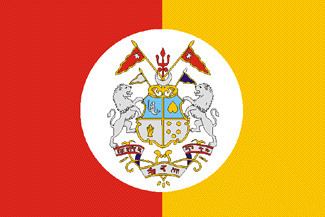1809–1949 → 1941 513,000 | Flag Coat of arms Founded 1809 Date dissolved 1949 | |
 | ||
1941 10,660 km (4,116 sq mi) | ||
Tripura State, also known as Hill Tipperah, was a princely state in India during the period of the British Raj and for some two years after the departure of the British. Its rulers belonged to the Manikya dynasty and until August 1947 the state was in a subsidiary alliance, from which it was released by the Indian Independence Act 1947. In 1949, it became one of the last princely states to accede to the newly-independent Indian Union.
Contents
The princely state was located in the present-day Indian state of Tripura. The state included one town, Agartala, as well as a total of 1,463 villages. It had an area of 10,660 km² and a population of 513,000 inhabitants in 1941.
History
The predecessor state of Tripura was founded about 100 AD. According to legend the Manikya dynasty derived its name from a jewel ('Mani' in Sanskrit) that had been obtained from a frog. The first king who ruled the state under the royal title of Manikya was Maharaja Maha Manikya who ascended the throne in 1400. The Rajmala, a chronicle of the Kings of Tripura, was written in Bengali verse in the 15th century under Dharma Manikya I. The kingdom of Tripura reached its maximum expansion in the 16th century.
In 1764, when the British East India Company took control of Bengal, the parts of Bengal that had been under the Mughal Empire were taken over by the British administration. In 1809 Tripura became a British protectorate and in 1838 the Rajas of Tripura were recognized by the British as sovereigns. Between 1826 and 1862 the eastern part was subject to the ravages caused by Kuki invaders that plundered and destroyed villages and massacred their inhabitants.
There were troubles in every succession among the Tripura royal family members when the aspiring princes often resorted to use the services of the Kukis to cause disturbances. Thus in 1904 the British enacted a sanad that regulated permanently the succession of the royal family. Thenceforward the succession would have to be recognized by the Viceroy of India representing the British Crown.
Bir Chandra Manikya (1862–1896) modelled his administration on the pattern of British India, and enacted reforms including the foundation of the Agartala Municipal Corporation. In 1905 Tripura became part of the new province of Eastern Bengal and Assam and was designated as 'Hill Tippera'. In addition to the Hill Tippera area, which corresponds to Tripura State, the kings retained a fertile estate known as Chakla Roshnabad with an area of 1476 km², located in the flatland of Noakhali, Sylhet and Tipperah districts; the latter is now mostly included in the Comilla District of Bangladesh.
The last king was Kirit Bikram Kishore, son of Bir Bikram Kishore Debbarma, who ruled for two years, 1947-1949. On 15 October 1949 the state acceded to the Indian Union as a consequence of the Tripura Merger Agreement signed by Queen Kanchan Prava Devi who was presiding the Council of Regency formed following the death of the last ruling King, Bir Bikram Kishore Debbarma.
Kirit Pradyot Debbarma (b. 1978) is the son of the last king.
Rulers
The head of the royal family of Tripura held the title of 'Maharaja' from 1919 onwards. Since 1897 the rulers were entitled to a 13 gun salute by the British authorities.
